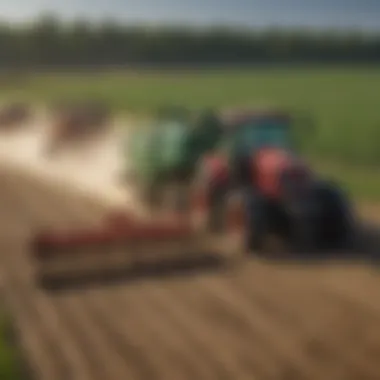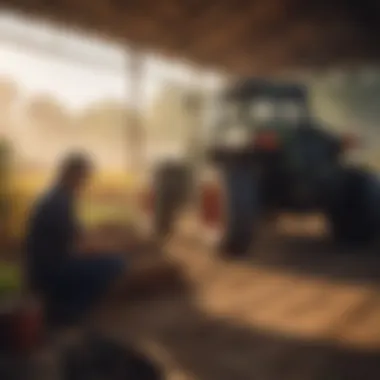Top 10 Side by Sides: Features and Performance


Intro
In recent years, side by side vehicles have gained substantial traction within the agricultural sector. They provide flexible and efficient transportation across varied terrains, making them invaluable for farmers and agricultural professionals. This article focuses on ten outstanding models of side by sides, analyzing their specifications and evaluating how well they serve in farming environments. Understanding these vehicles can transform productivity, leading to enhanced efficiency in operations and increased output.
Overview of the Topic
Definition and Importance
Side by sides, often referred to as utility task vehicles (UTVs), are designed to carry passengers and cargo, providing a blend of off-road capabilities and utility. Their design caters to agricultural needs, where maneuverability and power are essential. These vehicles play a crucial role in tasks such as transporting equipment, inspecting crops, and handling livestock.
Current Trends
Manufacturers are increasingly focusing on integrating advanced technology into side by sides. Features such as improved fuel efficiency, advanced suspension systems, and smart connectivity options are becoming standard. Farmers are looking for vehicles that not only meet their practical needs but also align with sustainability goals.
Key Techniques and Practices
Step-by-Step Guide
- Assessing Needs: Identify the primary functions and tasks you need your side by side for. This could range from light transportation to heavy load handling.
- Researching Models: Review the specifications of various models like Polaris Ranger and Kawasaki Mule. Compare attributes such as engine power, payload capacity, and fuel efficiency.
- Testing Performance: If possible, test drive a few vehicles. Gauge how each performs in real agricultural scenarios, paying attention to handling and comfort.
Tools and Equipment Needed
Investing in a side by side may also require additional equipment. Consider:
- Pallet forks for lifting.
- Dump beds for soil and debris transportation.
- Sprayers for crop treatment.
Challenges and Solutions
Common Obstacles
Common challenges with side by side vehicles include:
- Maintenance demands due to harsh agricultural conditions.
- Limited functionality for specialized farming needs.
- Navigating regulatory requirements regarding off-road vehicles.
Innovative Solutions
To overcome these challenges, consider the following solutions:
- Regular preventive maintenance ensures longevity and reliability.
- Customization options, from specialized attachments to enhanced safety features, improve functionality.
- Staying informed about local regulations helps in compliance and avoids potential penalties.
Prolusion to Side by Side Vehicles
Side by side vehicles have gained significant traction in the agricultural world, offering practical solutions tailored to various farming needs. Their importance cannot be understated, as they enhance operational efficiency while providing comfort and safety for those who operate them. This section outlines fundamental concepts behind these vehicles and discusses their evolution, highlighting the key elements that support their growing popularity among farmers and agricultural enthusiasts.
Understanding the Concept of Side by Sides
Side by side vehicles, commonly known as UTVs (Utility Task Vehicles), represent a versatile category of machinery designed for both work and recreation. Unlike traditional ATVs, side by sides boast seating for two or more passengers, enhancing their utility on farms or work sites. Their accessible design allows operators to maneuver easily, transport tools, and even carry produce across fields.
Key features often include:
- Four-wheel drivetrain: This allows for traction across diverse terrains.
- Cargo capacity: Many models provide ample storage for heavy tools and supplies.
- Safety features: Roll cages and adjustable seatbelts enhance user safety in various conditions.
Understanding these attributes is crucial as farmers assess their needs, helping them select the optimal vehicle for specific tasks.
The Evolution of Side by Side Technology
The technology behind side by side vehicles has evolved considerably over the years. Initially, these machines were basic, focusing primarily on utility. However, advancements in engineering have introduced enhancements that significantly improve performance and comfort.
Notable advancements include:


- Engine power: Modern models feature powerful engines that ensure they can handle heavy loads and harsh terrains.
- Suspension systems: Improved suspension systems contribute to a smoother ride, reducing wear on both the vehicle and operator.
- Safety innovations: Enhanced safety technologies, such as better braking systems and lighting, are now commonplace.
The evolution of side by sides illustrates a shift towards specialized machinery tailored for agricultural demands, improving productivity and making farming tasks more manageable. As these vehicles become more sophisticated, understanding their development helps farmers make informed purchasing choices suitable for their specific applications.
Criteria for Selection
Selecting the right side by side vehicle is paramount, particularly in the context of agriculture. The appropriate vehicle not only affects productivity but also enhances the safety and efficiency of various farming tasks. Considering the myriad options available on the market, it is essential to establish clear criteria for evaluating these vehicles. This section will discuss key elements such as performance metrics and safety features, which are crucial for making informed choices.
Key Performance Metrics
When evaluating side by side vehicles, key performance metrics serve as important indicators of their suitability for specific tasks. The following subsections will delve into three critical areas: power output, torque and handling, and suspension and stability.
Power Output
Power output refers to the vehicle's engine performance, a vital aspect that directly impacts its operational capacity. A higher power output means the vehicle can handle more demanding tasks, such as towing or transporting heavy loads. For farmers, this is advantageous, as it allows for greater efficiency in completing farm-related activities.
One of the most noteworthy characteristics of power output is its influence on speed and overall performance. Notably, vehicles like the Polaris RZR have been recognized for their impressive horsepower ratings. This makes them a popular choice among agricultural professionals who require robust capabilities.
However, it's important to consider the balance between power and fuel efficiency. Higher power can sometimes lead to increased fuel consumption, which may not be cost-effective in the long run.
Torque and Handling
Torque is another fundamental characteristic that highlights a vehicle's capacity to perform work. It determines how effectively a side by side can accelerate and navigate rough terrain, a common scenario in agricultural environments. The handling of the vehicle is closely related to its torque capabilities.
For instance, vehicles equipped with superior torque often exhibit enhanced handling, giving operators greater control when traversing uneven fields or navigating tight spaces. Models, such as the Can-Am Defender, are praised for their superior torque ratings and responsive handling. This combination is beneficial for farmers who need agility and reliability in their daily operations.
However, while high torque can enhance performance, it is essential to ensure that the vehicle remains manageable and safe, especially for less experienced users.
Suspension and Stability
The suspension system of a side by side plays a crucial role in maintaining stability during transit. Good suspension can absorb shocks from rough terrain, ensuring a more comfortable ride for the operator as well as reduced wear on the vehicle. Proper suspension contributes to better tire contact with the ground, which is essential in managing loads accurately.
A pivotal choice for those in agriculture, vehicles such as the Yamaha Wolverine feature advanced suspension systems that optimize stability. This stability is particularly crucial when carrying tools or equipment, reducing the risk of accidents.
Moreover, while a robust suspension system can improve comfort and control, it also requires regular maintenance to ensure it remains effective over time.
Safety Features
Safety features in side by side vehicles are vital to protect users and ensure safe operation, especially within agricultural settings. This categorization includes various elements such as seatbelts, roll cages, braking systems, and visibility aids.
Seatbelts and Roll Cages
Seatbelts and roll cages are fundamental safety components designed to protect operators in case of an accident. Roll cages provide a structural framework that significantly enhances the safety of the vehicle by preventing it from collapsing in a rollover situation. On the other hand, seatbelts serve to secure the operator, ensuring they remain safely inside the vehicle during operation.
For instance, models like the Honda Pioneer are equipped with high-quality roll cages and effective seatbelt systems, making them popular choices among farmers who prioritize safety. However, it is essential to inspect these features regularly to ensure their functionality.
Braking Systems
The braking system of a side by side is another crucial safety consideration. A reliable braking system enables the operator to stop quickly and effectively, particularly in emergency situations. Vehicles with superior braking capabilities are essential for maintaining control, especially when navigating hilly or challenging terrains.
For example, the Arctic Cat Wildcat features advanced braking systems that have been tested for responsiveness. However, operators must ensure the system undergoes regular inspections, as wear can decrease effectiveness.
Visibility and Lighting
Visibility and proper lighting are critical for safe operation, especially in low-light conditions. Adequate headlights and tail lights improve the operator's ability to navigate safely during dawn or dusk. Additionally, enhancing visibility around the vehicle can help in avoiding obstacles and ensuring the safety of both the operator and farm workers.
Many newer models, such as the John Deere Gator, come equipped with advanced visibility features, making them suitable for varied operating conditions. Yet, it's worth noting that without proper maintenance, lighting systems can degrade, leading to safety risks.
Top Ten Side by Side Vehicles Overview


The analysis of side by side vehicles is crucial for enthusiasts and professionals in agriculture. These vehicles, often referred to as UTVs (Utility Task Vehicles), serve specific roles that directly influence productivity on farms. As agricultural methods evolve, so does the need for efficient and reliable transportation solutions. The vehicles discussed in this section embody various characteristics which are relevant for application in farming scenarios.
Side by sides combine power, agility, and utility. Each model serves a purpose, whether for blending heavy-duty tasks with comfort or navigating rough terrains. Understanding these vehicles enables better decision-making when selecting the right tool for the job.
Criteria Used for Ranking
To offer a comprehensive overview of the top ten side by side vehicles, specific criteria were employed for their ranking. Assessment factors include but are not limited to:
- Performance Metrics: Evaluating aspects like speed, maneuverability, and power output.
- Durability and Build Quality: Construction materials and design resilience.
- User Feedback: Insights gathered from user experiences and reviews.
- Versatility: The ability to handle various tasks in different agricultural environments.
Detailed Analysis of Each Vehicle
Model One: Key Specifications
The Can-Am Defender offers exceptional versatility. Its powerful engine provides a robust output that caters to heavy lifting and towing requirements. This vehicle is well-liked for its spacious cargo areas, which can hold up to 1,000 pounds. Users appreciate its design that allows for easy access to the rear cargo, making loading and unloading efficient. However, some users note that its width may limit access to tighter areas on farms.
Model Two: User Reviews
The Polaris Ranger consistently receives praise in user reviews due to its all-rounded performance in various conditions. Many users mention its comfortable seating and smooth ride, which reduces fatigue during long hours of use. The high customer satisfaction rating stems from its reliability and ease of handling. Nevertheless, some reviews point out issues with engine noise at higher speeds, signaling a possible area for improvement.
Model Three: Performance Comparison
When comparing vehicles, the Yamaha Wolverine stands out for its balance between performance and comfort. Reviews note impressive acceleration paired with excellent suspension, which minimizes roughness over uneven terrains. This model is considered practical for farmers looking for reliability combined with a smoother experience on the trails. Some users, however, express concerns regarding fuel efficiency, particularly when heavy loads are transported.
Model Four: Practical Applications
The Honda Talon showcases its strengths in utility applications. It excels in hauling materials across farmlands while providing a user-friendly interface. Its compact size allows access to tighter spaces without sacrificing payload capacity. This model is favored among small scale farmers for its adaptability. Despite this, some users mention a need for more customizable options for specific tasks.
Model Five: Limitations
The Kawasaki Mule comes with notable limitations that are worth mentioning. While praised for its solid construction, it often falls short concerning speed and agility compared to competitors. Its practical design works well for daily tasks, but the sluggishness can be a drawback on larger farms requiring quicker transport solutions. The cargo capacity is respectable, yet some find other models more versatile for demanding needs.
Model Six: Market Trends
Recent market trends indicate a growing interest in electric side by side vehicles. Innovations such as the GEM eL XD emphasize sustainability while retaining utility. This shift reflects an increased awareness of environmental impact among farmers. Though initial costs of electric models might be higher, long-term savings on fuel attract many buyers. However, battery life remains a concern for some users, who prefer traditional fuel options for extensive daily use.
Model Seven: Expert Recommendations
Experts often recommend the John Deere RSX860M for its robust design and user-focused features. It is suitable for agricultural tasks, sports or leisure activities. Reviews from specialists highlight its safety features, including a roll cage and secure seatbelts. It is regarded as a good investment, though some argue it lacks top-end speed compared to racing-focused models.
Model Eight: Cost Efficiency
Cost efficiency is critical for farmers managing budgets. The Viking VI presents an attractive option with its cost-to-value ratio. It provides ample utility without breaking the bank. Many find it reliable for regular tasks like hauling or transportation of materials. However, a few users criticize the lack of additional features that other, more expensive models provide, indicating a trade-off between cost and capability.
Model Nine: Maintenance Insights
Maintenance plays a key role in vehicle lifespan and performance. The Kubota RTV-X1140 is often highlighted for its ease of maintenance, with accessible engine components. This model offers farmers peace of mind, contributing to lower total ownership costs. While efficiency is commendable, some users note that replacement parts can be pricier compared to others in its category.
Model Ten: User Experience Metrics
User experience metrics are essential for understanding vehicle performance in real-world conditions. The Arctic Cat Prowler often rates high in overall user satisfaction. The spacious cabin, smooth drive, and reliable transmission are significant factors contributing to positive ratings. However, some feedback regarding fuel efficiency emerges, which could be a concern for those using it frequently over long distances.
In summary, evaluating side by side vehicles through these various lenses can significantly affect agricultural operations. Each model presents unique strengths and potential drawbacks. Understanding these details ensures farmers make informed decisions tailored to their specific requirements.
Applications in Agriculture
In the context of side by side vehicles, their role in agriculture cannot be overstated. They serve as versatile tools that vastly improve the efficiency and productivity of farming operations. For agricultural professionals and enthusiasts, understanding how these vehicles integrate into daily tasks can lead to better decision-making regarding their use.
The various applications of side by sides also highlight technologies and features that specifically cater to agricultural needs. Farmers are constantly looking for solutions that help them manage their farms with greater ease. This is where side by sides come into play. Their design and capabilities empower users to navigate tough terrains, carry heavy loads, and perform a range of agricultural tasks.


Enhancing Farm Efficiency
To begin with, side by sides improve farm efficiency in several notable ways. These vehicles are capable of covering large distances quickly, which is essential during busy farming seasons. The enhanced speed allows farmers to transport tools, seeds, and supplies without wasting precious time, thus contributing to streamlined workflows.
- Maneuverability: Side by sides are often designed to handle uneven and rugged terrain. This characteristic makes them more adept than traditional vehicles in reaching remote areas of a farm.
- Heavy-Towing Capacity: Many models come with powerful engines that allow them to tow heavier trailers. This enables farmers to carry larger loads in less time.
- Flexibility: Their ability to adapt to multiple purposes, such as transporting materials or assisting with maintenance tasks, further augments farm efficiency.
Role in Crop Management
Crop management is another critical area where side by sides prove valuable. Farmers rely on these vehicles to manage large expanses of land.
- Field Inspections: Regular inspections are crucial in identifying pest infestations or crop diseases. Side by sides can facilitate quicker access for visual assessments.
- Transportation of Materials: Seeds, fertilizers, and pesticides can be delivered easily across fields using these vehicles, minimizing the need for multiple trips.
- Crop Monitoring: Some advanced models are equipped with technology that assists in monitoring crop health through integrated sensors, thus offering a more data-driven approach to farming.
Utility in Horticulture
The utility of side by sides extends to horticulture as well. In this sub-sector, where precision is key, these vehicles provide unique benefits.
- Access to Tight Spaces: Horticulture often involves navigating through areas where larger machinery cannot fit. Side by sides allow easy movement in these restricted spaces, making maintenance and harvesting more efficient.
- Mobility for Irrigation Management: Side by sides can transport water and other necessary supplies for irrigation effectively, ensuring that farmers can maintain moisture levels in crops without delay.
- Practicality in Landscaping Tasks: For farmers involved in ornamental plants and landscape maintenance, side by sides help in transporting tools and materials like mulch and stone.
In summary, side by side vehicles prove to be essential tools in the agricultural sector, enhancing efficiency and facilitating better crop management. Their role in horticulture further illustrates their versatility, making them indispensable in modern farming environments. Understanding these applications can guide farmers in selecting the most appropriate vehicles to suit their needs.
Future of Side by Side Vehicles
The future of side by side vehicles holds significant importance for agricultural operations. These vehicles have evolved dramatically over the years, adapting to the changing needs of farmers and the agricultural industry as a whole. As technology progresses, so do the features and capabilities of side by side vehicles, which can greatly influence both efficiency and productivity on the farm. Understanding these advancements is essential for farmers and industry stakeholders in order to remain competitive and effective in their practices.
As we look ahead, several specific elements will play a crucial role in shaping the future of these vehicles. Innovations in design, technology integration, and sustainability considerations will be at the forefront of this evolution. Each of these areas brings its own set of benefits and challenges, which will be analyzed in the following sections.
Innovations in Design and Technology
Innovative designs in side by sides have transitioned from basic utility vehicles to sophisticated machines equipped with advanced technology. Manufacturers are increasingly focusing on integrating features such as GPS tracking, improved user interfaces, and enhanced suspension systems that enhance comfort and handling. These improvements not only make these vehicles more enjoyable to operate but also maximize their effective use in various agricultural contexts.
For instance, models equipped with
- Smart technology for route optimization can significantly reduce time spent on tasks such as crop inspection or field maintenance.
- Enhanced fuel efficiency systems contribute to lower operational costs.
Additionally, the rise of electric and hybrid models reflects the industry's shift toward greener alternatives. This transformation is essential, as farmers are increasingly prioritizing energy-efficient solutions to minimize their environmental impact. Electric side by sides, which produce less noise and emissions, cater to those looking to operate sustainably.
Sustainability Considerations
Sustainability in agriculture is becoming more consequential with the impacts of climate change and resource management. The future of side by side vehicles must align with these sustainability goals. Manufacturers are focusing on developing vehicles that consume less fuel and have a reduced carbon footprint.
Key points about sustainability in side by side vehicles include:
- Durable materials: Using long-lasting and recycled materials can decrease waste over the product lifecycle.
- Modular designs: These allow for easy upgrades and repairs, prolonging the vehicle's lifespan.
- Multi-functionality: Vehicles that can perform various tasks decrease the need for multiple machines, leading to fewer overall environmental impacts.
Adopting sustainable practices not only meets regulatory demands but can also resonate with consumers who prioritize eco-friendly products. As such, side by sides positioned as eco-conscious choices might gain preference among farmers looking to enhance their sustainability profile.
"The integration of sustainability into side by side vehicles is not just a trend; it's a necessity for the future of agriculture."
Culmination
In this article, we have explored the vital aspects of side by side vehicles, particularly in the context of agricultural applications. The importance of understanding how to select the right vehicle cannot be overstated. Every model brought forth different features and capabilities, which can greatly influence efficiency on the farm.
Summary of Findings
Throughout the article, we analyzed ten side by side vehicles. The evaluations focused on performance metrics such as power output and handling, alongside safety features. Understanding these factors helps users determine their usefulness in specific situations. Here are key takeaways of the findings:
- Performance Metrics: Each vehicle presented unique specifications that showcased their strengths and weaknesses.
- Safety Features: Safety is a critical point of concern, with many models offering roll cages and advanced braking systems.
- User Experience: Feedback from actual users revealed practical insights regarding the day-to-day operation of these vehicles in agricultural settings.
"The investment in the right side by side can significantly enhance productivity and ensure safety during operations."
Final Thoughts on Selection and Usage
Selecting the right side by side vehicle involves careful consideration of specific needs and farm requirements. Various models shine in different areas, such as load capacity, terrain handling, and comfort during long hours of use. It is advisable for users to assess their operational demands before making a decision.
- Research: Identify the type of agriculture being practiced.
- Evaluate: Compare the features of different models to ensure they align with specific tasks.
- Seek Advice: Warmly engage fellow farmers and enthusiasts to gather their experiences.
The right side by side vehicle does more than merely serve as a mode of transport; it augments the entire farming experience, providing increased efficiency and safety.



